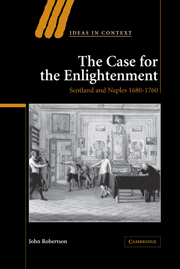Book contents
- Frontmatter
- Contents
- Preface
- 1 The case for the Enlightenment
- 2 Scotland and Naples in 1700
- 3 The intellectual worlds of Naples and Scotland 1680–c.1725
- 4 The predicament of ‘kingdoms governed as provinces’
- 5 Vico, after Bayle
- 6 Hume, after Bayle and Mandeville
- 7 The advent of Enlightenment: political economy in Naples and Scotland 1730–1760
- Conclusion: the Enlightenment vindicated?
- Bibliography
- Index
- IDEAS IN CONTEXT
6 - Hume, after Bayle and Mandeville
Published online by Cambridge University Press: 15 October 2009
- Frontmatter
- Contents
- Preface
- 1 The case for the Enlightenment
- 2 Scotland and Naples in 1700
- 3 The intellectual worlds of Naples and Scotland 1680–c.1725
- 4 The predicament of ‘kingdoms governed as provinces’
- 5 Vico, after Bayle
- 6 Hume, after Bayle and Mandeville
- 7 The advent of Enlightenment: political economy in Naples and Scotland 1730–1760
- Conclusion: the Enlightenment vindicated?
- Bibliography
- Index
- IDEAS IN CONTEXT
Summary
FINDING ‘DIVERSION AND IMPROVEMENT’ IN BAYLE
At some point in the spring or early summer of 1729, the eighteen-year-old David Hume experienced ‘a new Scene of Thought’, which inspired him ‘to throw up every other Pleasure or Business’ to devote himself entirely to it. The ‘new Scene of Thought’ was almost certainly the germ of the Treatise of Human Nature. But for reasons he would explain at length in the ‘Letter to a Physician’ of March 1734, Hume was unable to realise the promise of that revelatory moment for over five years. A succession of physical complaints prevented him devoting himself to sustained work; but Hume also observed that his attempts to console himself with ‘peevish Reflections on the vanity of the World & of all humane Glory’ – the shibboleths of Stoic philosophy – had been to no avail. If he found any relief during this period, it was apparently in a work by Bayle, which he recommended to his friend Michael Ramsay in 1732 as ‘a Book you will yourself find Diversion & Improvement in’. What this book was is not known. It may have been the Dictionnaire historique et critique, but it may also have been the collected Oeuvres Diverses, recently published at The Hague in four volumes between 1727 and 1731. It may not be coincidental that during this period Hume also filled what he later described as a ‘Manuscript Book’, in which he recorded the gradual progress of his thoughts (or doubts) on religion.
- Type
- Chapter
- Information
- The Case for The EnlightenmentScotland and Naples 1680–1760, pp. 256 - 324Publisher: Cambridge University PressPrint publication year: 2005
- 5
- Cited by



